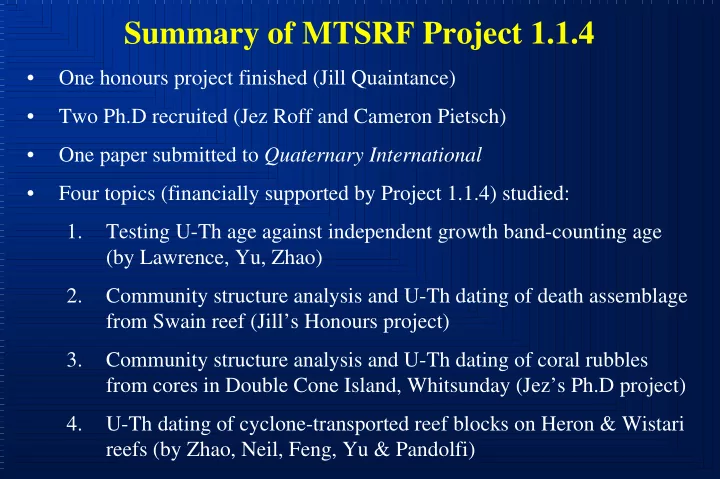

Summary of MTSRF Project 1.1.4 • One honours project finished (Jill Quaintance) • Two Ph.D recruited (Jez Roff and Cameron Pietsch) • One paper submitted to Quaternary International • Four topics (financially supported by Project 1.1.4) studied: 1. Testing U-Th age against independent growth band-counting age (by Lawrence, Yu, Zhao) 2. Community structure analysis and U-Th dating of death assemblage from Swain reef (Jill’s Honours project) 3. Community structure analysis and U-Th dating of coral rubbles from cores in Double Cone Island, Whitsunday (Jez’s Ph.D project) 4. U-Th dating of cyclone-transported reef blocks on Heron & Wistari reefs (by Zhao, Neil, Feng, Yu & Pandolfi)
U-series ages vs coral growth band-counting ages (For Lawrence’s Ph.D thesis, ages determined by Yu & Zhao) Upper portion of SMI-01C core • Five U-Th ages determined: 1981 ± 1, 1942 ± 1, 1842 ± 3, 1843 ± 6, and 1798 ± 5 AD • 1 st and 2 nd ages perfectly match with band-counting ages • The 3 rd and 4 th ages identify an off-axis section with the growth layer nearly parallel to the sampling traverse (agree with unpublished AIMS UV luminescence chronology by Dr Lough) the 5 th age defines the age of a broken section with floating • chronology • Overall, the U-Th ages agree with band-counting ages very well.
Honour’s student Jill Quaintance’s Thesis Project Coral community structure in life and death assemblages from the Swain Reefs, Great Barrier Reef, Australia •5-135 km from Mackay •European settlement (1865) –Cattle farming –Sugar mills •Pioneer river (1,570 sq km catchment area)
Methods � 6 reefs � 2 sites at each reef � 2 transects at each site � 50 m transects � Death Assemblages • Loose coral rubble • 6 ~1 liter volume samples from each transect • weight of colonies per taxonomic group • Number of colonies per taxonomic group • U-series dating of coral colonies from Keswick Island � Life Assemblages • 0.25 m 2 quadrats every other meter
Results � Significant difference between life and death assemblage, by all methods � Death assemblage relatively modern <250 years Question � What might have influenced these changes?
Jian-xin Zhao: Jian-xin Zhao: 10 branching coral rubbles were 10 branching coral rubbles were chosen for U-Th dating. The results chosen for U-Th dating. The results display an age population peak at McCulloch et al. (2003, display an age population peak at 1890 AD which declined toward 1890 AD which declined toward Nature 421: 727-730) present time. If branching coral present time. If branching coral population had not changed, we population had not changed, we would expect younger coral rubbles would expect younger coral rubbles outnumber older ones due to outnumber older ones due to decreasing survival probability with decreasing survival probability with age as a result of erosion. Our age as a result of erosion. Our working hypothesis for the age working hypothesis for the age distribution pattern is that branching distribution pattern is that branching coral coverage started to decrease coral coverage started to decrease following European settlement and following European settlement and cattle farming from 1865 AD in the cattle farming from 1865 AD in the region. Ba/Ca proxy data of region. Ba/Ca proxy data of McCulloch et al. (2003) for a coral in McCulloch et al. (2003) for a coral in the region suggest that sediment the region suggest that sediment flux into the GBR increased since flux into the GBR increased since 1870, coinciding with farming in the 1870, coinciding with farming in the 4 Pioneer River catchment. It is likely Pioneer River catchment. It is likely progressive farming has had an European progressive farming has had an 3 Number of accumulative effect on the more Count accumulative effect on the more Settlement vulnerable branching coral species, vulnerable branching coral species, U-Th ages resulting in progressive stress and 2 1865 AD resulting in progressive stress and reduction in branching coral reduction in branching coral coverage. 1 coverage. 0 This working hypothesis needs to This working hypothesis needs to 1775 1800 1825 1850 1875 1900 1925 1950 1975 2000 be tested by far more dating. We be tested by far more dating. We plan to increase the age population plan to increase the age population Age (AD) by 5-10 time to assess whether this by 5-10 time to assess whether this is the case. is the case.
Ph.D student Jez Roff’s Project • 15 cores extracted from Double Cone Island, Whitsunday • 6 cores with coral ID to species or genus levels • Core DCI26 (left) – 180 cm long • Top-base ages determined using two coral fragments – 1. 0-5 cm, 8 ± 5 yrs old 2. 175-180 cm, 1184 ± 68 yrs old • Age errors due to correction for impurities in corals
U-Th dating of cyclone-transported coral reef blocks (by Zhao, Neil, Feng, Yu & Pandolfi) Sample localities Heron reef Wistari reef 5 KM 5 Sample mortality Number of Cyclone name age (AD) 4 1970 ± 4 HR-1 Mortality 1907 ± 1 3 HR-2 ages 1944 ± 1 HR-3 2 1914 ± 3 HR-4 1734 ± 4 1 HR-5 1943 ± 3 WRW-3 0 1900 1920 1940 1960 1980 2000 Year (AD)
Recommend
More recommend